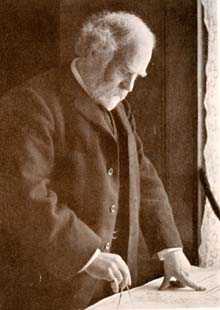John Murray (oceanographer)
| John Murray | |
|---|---|
 Sir John Murray, 1902 | |
| Born |
March 3, 1841 Cobourg, Ontario, Canada |
| Died |
March 16, 1914 (aged 73) Kirkliston, Midlothian, Scotland |
| Citizenship | United Kingdom |
| Nationality | Scottish |
| Fields |
oceanography limnology |
| Institutions |
Naturalist with the Challenger Expedition Commission (1872) Director of the Challenger Expedition Commission (1882) Established marine laboratories at Granton and Millport Bathymetric Survey of the Freshwater Lochs of Scotland (1897-1909) |
| Alma mater | Edinburgh University |
| Notable awards |
Makdougall-Brisbane Prize (1884-6) Neill Prize (1877-80) |
| Author abbreviation (botany) | J.Murray |
|
Notes Fellow of the Royal Society of Edinburgh (1876) Fellow of the Royal Society of London (1896) President of the Royal Scottish Geographical Society (1898-1904) President of the Scottish Natural History Society Member of the Scottish Meteorological Society | |
Sir John Murray KCB FRS FRSE FRSGS (3 March 1841 – 16 March 1914) was a pioneering Scottish oceanographer, marine biologist and limnologist.[1]
Early life
Murray was born at Cobourg, Ontario, Canada, to Scottish parents - Robert Murray, accountant, and Elizabeth Macfarlane - who had emigrated 7 years earlier. He returned to Scotland as a child, and was educated at Stirling High School and the University of Edinburgh (1864-5), but soon left to join a whaling expedition to Spitsbergen as ships' surgeon in 1868.
He returned to Edinburgh to complete his studies (1868–72) in geology under Sir Archibald Geikie and natural philosophy under Peter Guthrie Tait.
Challenger Expedition
Tait introduced Murray to Charles Wyville Thomson who had been appointed to lead the Challenger Expedition. In 1872, Murray joined Wyville Thomson as his assistant on this four-year expedition to explore the deep oceans of the globe. After Wyville Thompson succumbed to the stress of publishing the reports of the Challenger Expedition, Murray took over, and edited and published over 50 volumes of reports, which were completed in 1896. Murray was killed when his car overturned near his home on 16 March 1914 at Kirkliston, Edinburgh; he is buried at the nearby Dean Kirkyard.
In 1884,[2] Murray set up the Marine Laboratory at Granton, Edinburgh, the first of its kind in the United Kingdom. In 1894, this laboratory was moved to Millport, Isle of Cumbrae, on the Firth of Clyde, and became the University Marine Biological Station, Millport, the forerunner of today's Scottish Association for Marine Science at Dunstaffnage, near Oban, Argyll and Bute.
In 1909, Murray wrote to the Norwegian government that if they would lend the Michael Sars vessel to him for a four-month research cruise, under Johan Hjort's scientific command, then Murray would pay all expenses. After a winter of preparation, this resulted in by that time the most ambitious oceanographic research cruise ever. The 1912 Murray and Hjort book The Depths of the Ocean quickly became a classic for marine naturalists and oceanographers.
He was the first to note the existence of the Mid-Atlantic Ridge and of oceanic trenches. He also noted the presence of deposits derived from the Saharan desert in deep ocean sediments and published a vast number of papers on his findings. His last major contribution to science was coordinating a bathymetric survey of 562 of Scotland's freshwater lochs in 1897, involving over 60,000 individual depth soundings, which were published in 6 volumes in 1910. He was president of the Royal Scottish Geographical Society from 1898 to 1904. He was elected a Fellow of the Royal Society in June 1896,[3] having been awarded their Royal Medal the previous year.
He was invested as a KCB in 1898.
He was awarded the Clarke Medal by the Royal Society of New South Wales in 1900. His name is remembered in the John Murray Laboratories at the University of Edinburgh, the John Murray Society at the University of Newcastle, and the Scottish Environment Protection Agency research vessel, the S.V. Sir John Murray. In addition, the Cirrothauma murrayi octopus, which lives on depths from 1500 m to 4500 m and lacks object recognition abilities, is named after Murray, as are the Murrayonida sea sponges.
In 1911, he founded the Alexander Agassiz Medal, awarded by the National Academy of Sciences, in memory of his friend Alexander Agassiz (1835–1910).
See also
References
- ↑ Waterston, Charles D; Macmillan Shearer, A (July 2006). Former Fellows of the Royal Society of Edinburgh 1783-2002: Biographical Index II. Edinburgh: The Royal Society of Edinburgh. ISBN 978-0-902198-84-5. Archived from the original on 2006-10-04. Retrieved 23 August 2013.
- ↑ Overview of Dunstaffnage ik Marine Laboratory
- ↑ "Library and Archive catalogue". The Royal Society. Retrieved 2 October 2010.
- ↑ "Author Query for 'J.Murray'". International Plant Names Index.
External links
 Works written by or about John Murray at Wikisource
Works written by or about John Murray at Wikisource- On the 1910 Murray and Hjort expedition and the Cirrothauma murrayi octopus
| Awards | ||
|---|---|---|
| Preceded by Augustus Gregory |
Clarke Medal 1900 |
Succeeded by Edward John Eyre |
|